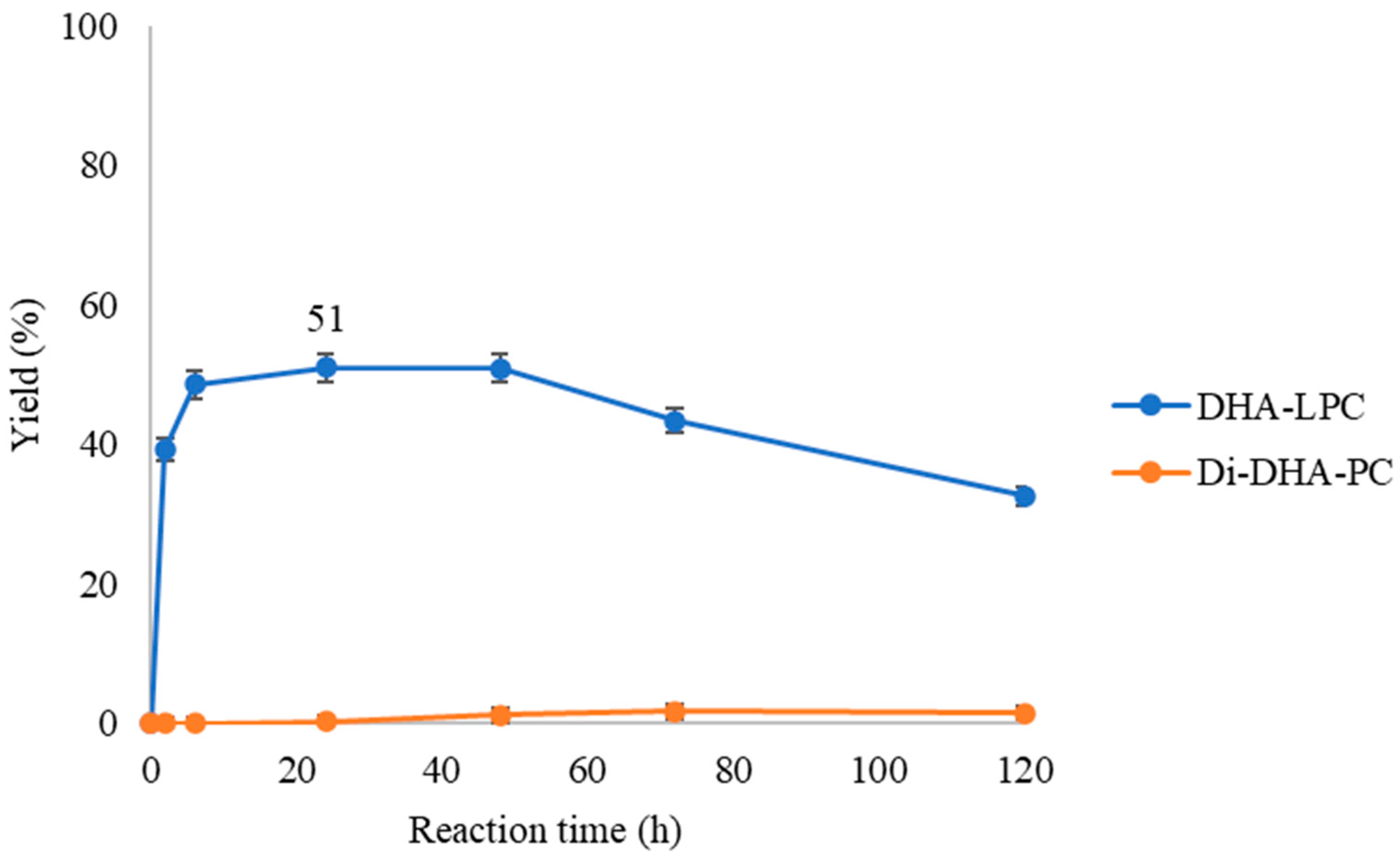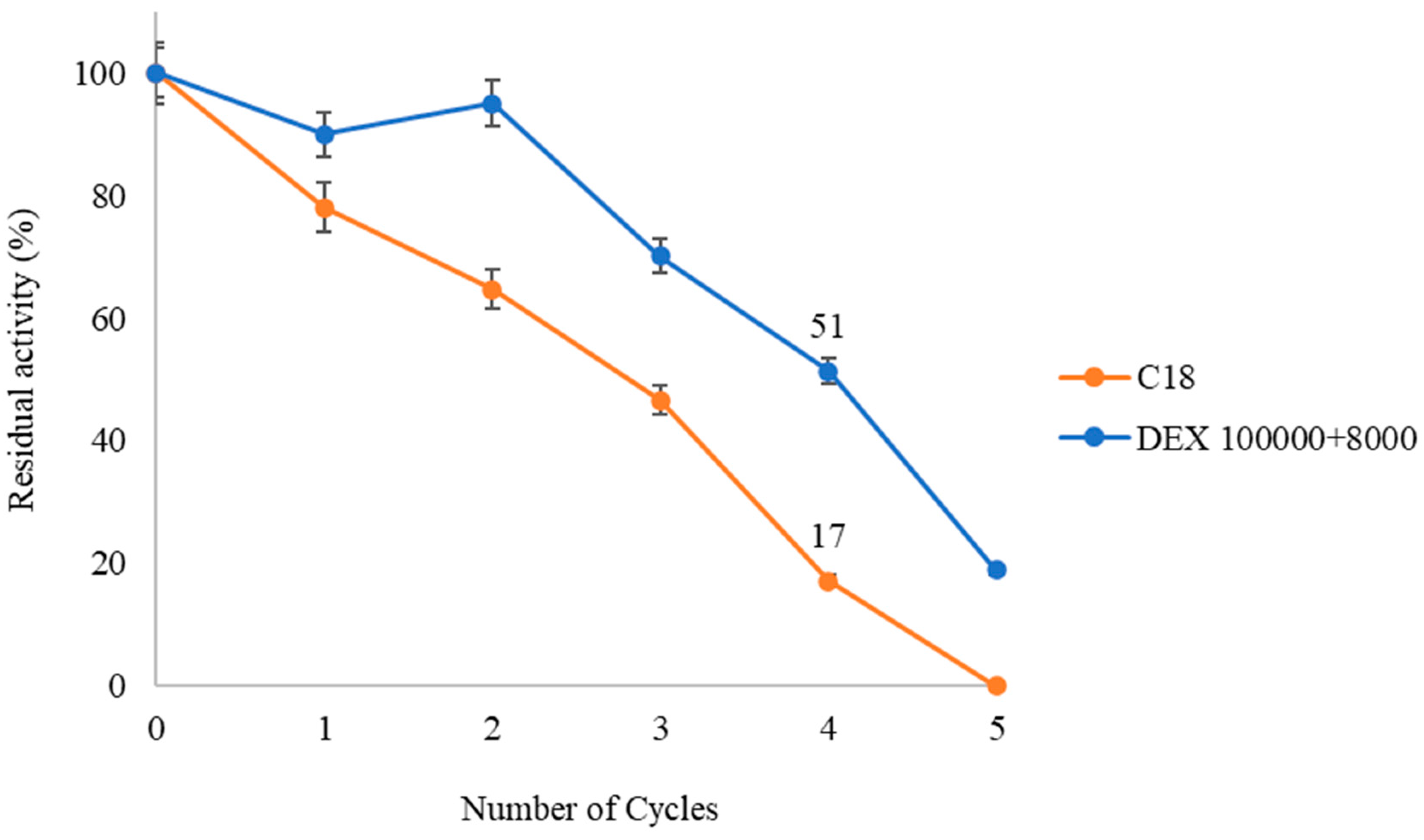Enzymatic Synthesis of Bioactive Structured DHA Phospholipids via Stable Immobilized Phospholipase-Catalyzed Esterification in a Solvent-Free Medium
Abstract
:1. Introduction
2. Materials and Methods
2.1. Materials
2.2. Methods
2.2.1. Determination of the Activity of Different Soluble and Immobilized Lipases
2.2.2. Immobilization of Lipases/Phospholipases on the Hydrophobic Support Immobeads-C18
2.2.3. Physicochemical Modifications of Immobilized Enzymes
Amination
Adsorption of Anionic Polymer
2.2.4. Drying of Lipases and Phospholipases Derivatives
2.2.5. Enzymatic Synthesis of Structured Phospholipids from Docosahexaenoic Acid
2.2.6. Stability of Physicochemically Modified Derivatives for the Synthesis of DHA Phospholipids
2.2.7. Reuse of Phospholipase Derivatives in the Esterification Reaction
2.3. Product Analysis
Quantitative Analysis by High-Performance Liquid Chromatography (HPLC)
3. Results and Discussion
3.1. Immobilization of Lipases/Phospholipases with Maximum Enzyme Loading
3.2. Enzymatic Synthesis of Di-DHA-PC by Direct Condensation of DHA and GPC in Solvent-Free System
3.3. Profile of DHA Phospholipid Synthesis Catalyzed by Different Lipases and Phospholipases Immobilized on C18 in Solvent-Free Media
3.4. Effect of the Solvent on the Esterification of GPC with DHA Catalyzed by Immobilized Phospholipase QlowP
3.5. Stabilization Strategies for QlowP-C18 Using Post-Immobilization Techniques
3.6. Stability of the Different QlowP-C18 Derivatives Under the Reaction Conditions
3.7. Operational Stability of the QlowP-C18 Catalyst
4. Conclusions
Author Contributions
Funding
Data Availability Statement
Acknowledgments
Conflicts of Interest
References
- Dangour, A.D.; Uauy, R. N-3 Long-Chain Polyunsaturated Fatty Acids for Optimal Function during Brain Development and Ageing. Asia Pac. J. Clin. Nutr. 2008, 17 (Suppl. S1), 185–188. [Google Scholar]
- Ting, Y.; Jiang, Y.; Ho, C.-T.; Huang, Q. Common Delivery Systems for Enhancing in Vivo Bioavailability and Biological Efficacy of Nutraceuticals. J. Funct. Foods 2014, 7, 112–128. [Google Scholar] [CrossRef]
- Parmentier, M.; Al Sayed Mahmoud, C.; Linder, M.; Fanni, J. Polar Lipids: N-3 PUFA Carriers for Membranes and Brain: Nutritional Interest and Emerging Processes. Oléagineux Corps Gras Lipides 2007, 14, 224–229. [Google Scholar] [CrossRef]
- Burri, L.; Hoem, N.; Banni, S.; Berge, K. Marine Omega-3 Phospholipids: Metabolism and Biological Activities. Int. J. Mol. Sci. 2012, 13, 15401–15419. [Google Scholar] [CrossRef] [PubMed]
- Hachem, M.; Nacir, H. Emerging Role of Phospholipids and Lysophospholipids for Improving Brain Docosahexaenoic Acid as Potential Preventive and Therapeutic Strategies for Neurological Diseases. Int. J. Mol. Sci. 2022, 23, 3969. [Google Scholar] [CrossRef] [PubMed]
- Pan, Y.; Scanlon, M.J.; Owada, Y.; Yamamoto, Y.; Porter, C.J.H.; Nicolazzo, J.A. Fatty Acid-Binding Protein 5 Facilitates the Blood–Brain Barrier Transport of Docosahexaenoic Acid. Mol. Pharm. 2015, 12, 4375–4385. [Google Scholar] [CrossRef] [PubMed]
- Ouellet, M.; Emond, V.; Chen, C.T.; Julien, C.; Bourasset, F.; Oddo, S.; LaFerla, F.; Bazinet, R.P.; Calon, F. Diffusion of Docosahexaenoic and Eicosapentaenoic Acids through the Blood–Brain Barrier: An in Situ Cerebral Perfusion Study. Neurochem. Int. 2009, 55, 476–482. [Google Scholar] [CrossRef]
- Chouinard-Watkins, R.; Lacombe, R.J.S.; Metherel, A.H.; Masoodi, M.; Bazinet, R.P. DHA Esterified to Phosphatidylserine or Phosphatidylcholine Is More Efficient at Targeting the Brain than DHA Esterified to Triacylglycerol. Mol. Nutr. Food Res. 2019, 63, e1801224. [Google Scholar] [CrossRef] [PubMed]
- Sugasini, D.; Yalagala, P.C.R.; Goggin, A.; Tai, L.M.; Subbaiah, P.V. Enrichment of Brain Docosahexaenoic Acid (DHA) Is Highly Dependent upon the Molecular Carrier of Dietary DHA: Lysophosphatidylcholine Is More Efficient than Either Phosphatidylcholine or Triacylglycerol. J. Nutr. Biochem. 2019, 74, 108231. [Google Scholar] [CrossRef] [PubMed]
- Semba, R.D. Perspective: The Potential Role of Circulating Lysophosphatidylcholine in Neuroprotection against Alzheimer Disease. Adv. Nutr. 2020, 11, 760–772. [Google Scholar] [CrossRef] [PubMed]
- Pencreac’h, G.; Ergan, F.; Poisson, L. Production of Lysophospholipids Rich in DHA. Lipid Technol. 2011, 23, 250–252. [Google Scholar] [CrossRef]
- Pencreac’h, G.; Ergan, F.; Poisson, L. DHA-Lysophospholipid Production. Curr. Org. Chem. 2013, 17, 793–801. [Google Scholar] [CrossRef]
- Uprety, B.K.; Morrison, E.N.; Emery, R.J.N.; Farrow, S.C. Customizing Lipids from Oleaginous Microbes: Leveraging Exogenous and Endogenous Approaches. Trends Biotechnol. 2022, 40, 482–508. [Google Scholar] [CrossRef]
- Castejón, N.; Señoráns, F.J. Enzymatic Modification to Produce Health-Promoting Lipids from Fish Oil, Algae and Other New Omega-3 Sources: A Review. New Biotechnol. 2020, 57, 45–54. [Google Scholar] [CrossRef] [PubMed]
- Xu, Q.; Tang, Q.; Xu, Y.; Wu, J.; Mao, X.; Li, F.; Wang, S.; Wang, Y. Biotechnology in Future Food Lipids: Opportunities and Challenges. Annu. Rev. Food Sci. Technol. 2023, 14, 225–246. [Google Scholar] [CrossRef]
- Zhang, Y.; Wang, X.; Xie, D.; Zou, S.; Jin, Q.; Wang, X. Synthesis and Concentration of 2-Monoacylglycerols Rich in Polyunsaturated Fatty Acids. Food Chem. 2018, 250, 60–66. [Google Scholar] [CrossRef] [PubMed]
- Moreno-Pérez, S.; Guisan, J.M.; Fernandez-Lorente, G. Selective Ethanolysis of Fish Oil Catalyzed by Immobilized Lipases. JAOCS J. Am. Oil Chem. Soc. 2014, 91, 63–69. [Google Scholar] [CrossRef]
- Lopes, P.A.; Alfaia, C.M.; Pestana, J.M.; Prates, J.A.M. Structured Lipids Engineering for Health: Novel Formulations Enriched in n-3 Long-Chain Polyunsaturated Fatty Acids with Potential Nutritional Benefits. Metabolites 2023, 13, 1060. [Google Scholar] [CrossRef] [PubMed]
- Kim, J.; Kim, B.-G. Lipase-Catalyzed Synthesis of Lysophosphatidylcholine Using Organic Cosolvent for in Situ Water Activity Control. J. Am. Oil Chem. Soc. 2000, 77, 791–797. [Google Scholar] [CrossRef]
- Hong, S.I.; Kim, Y.; Kim, C.T.; Kim, I.H. Enzymatic Synthesis of Lysophosphatidylcholine Containing CLA from Sn-Glycero-3-Phosphatidylcholine (GPC) under Vacuum. Food Chem. 2011, 129, 1–6. [Google Scholar] [CrossRef]
- Virto, C.; Svensson, I.; Adlercreutz, P. Enzymatic Synthesis of Lysophosphatidic Acid and Phosphatidic Acid. Enzym. Microb. Technol. 1999, 24, 651–658. [Google Scholar] [CrossRef]
- Virto, C.; Adlercreutz, P. Lysophosphatidylcholine Synthesis with Candida Antarctica Lipase B (Novozym 435). Enzym. Microb. Technol. 2000, 26, 630–635. [Google Scholar] [CrossRef] [PubMed]
- Mnasri, T.; Hérault, J.; Gauvry, L.; Loiseau, C.; Poisson, L.; Ergan, F.; Pencréac’h, G. Lipase-Catalyzed Production of Lysophospholipids. OCL 2017, 24, D405. [Google Scholar] [CrossRef]
- Marsaoui, N.; Naghmouchi, K.; Baah, J.; Raies, A.; Laplante, S. Incorportation of Ethyl Esters of EPA and DHA in Soybean Lecithin Using Rhizomucor Miehei Lipase: Effect of Additives and Solvent-Free Conditions. Appl. Biochem. Biotechnol. 2015, 176, 938–946. [Google Scholar] [CrossRef] [PubMed]
- Malipeddi, H.; Das, P.; Karigar, A. Green Technique-Solvent Free Synthesis and Its Advantages. IJRAP 2011, 2, 1079–1086. [Google Scholar]
- Guisan, J.M. Immobilization of Enzymes as the 21st Century Begins. In Immobilization of Enzymes and Cells; Guisan, J.M., Ed.; Methods in BiotechnologyTM; Humana Press: Totowa, NJ, USA, 2006; pp. 1–13. ISBN 978-1-59745-053-9. [Google Scholar]
- Fernandez-Lorente, G.; Cabrera, Z.; Godoy, C.; Fernandez-Lafuente, R.; Palomo, J.M.; Guisan, J.M. Interfacially Activated Lipases against Hydrophobic Supports: Effect of the Support Nature on the Biocatalytic Properties. Process Biochem. 2008, 43, 1061–1067. [Google Scholar] [CrossRef]
- Facin, B.R.; Quinto, E.G.; Valerio, A.; Oliveira, D.D.; Oliveira, J.V.; Fernandez-Lorente, G. Strategies for the Immobilization of Eversa® Transform 2.0 Lipase and Application for Phospholipid Synthesis. Catalysts 2021, 11, 1236. [Google Scholar] [CrossRef]
- Bolivar, J.M.; Rocha-Martín, J.; Mateo, C.; Guisan, J.M. Stabilization of a Highly Active but Unstable Alcohol Dehydrogenase from Yeast Using Immobilization and Post-Immobilization Techniques. Process Biochem. 2012, 47, 679–686. [Google Scholar] [CrossRef]
- Martins, P.A.; Trobo-Maseda, L.; Lima, F.A.; de Morais Júnior, W.G.; De Marco, J.L.; Salum, T.F.C.; Guisán, J.M. Omega-3 Production by Fish Oil Hydrolysis Using a Lipase from Burkholderia Gladioli BRM58833 Immobilized and Stabilized by Post-Immobilization Techniques. Biochem. Biophys. Rep. 2022, 29, 101193. [Google Scholar] [CrossRef]
- Lin, W.-C.; Yu, D.-G.; Yang, M.-C. Blood Compatibility of Thermoplastic Polyurethane Membrane Immobilized with Water-Soluble Chitosan/Dextran Sulfate. Colloids Surf. B Biointerfaces 2005, 44, 82–92. [Google Scholar] [CrossRef]
- Thies, F.; Pillon, C.; Moliere, P.; Lagarde, M.; Lecerf, J. Preferential Incorporation of M-2 1ysoPC DHA over Unesterified DHA in the Young Rat Brain. Am. J. Physiol.-Regul. Integr. Comp. Physiol. 1994, 267, 1273–1279. [Google Scholar] [CrossRef] [PubMed]
- Thies, F.; Delachambre, M.C.; Bentejac, M.; Lagarde, M.; Lecerf, J. Unsaturated Fatty Acids Esterified in 2-Acyl- 1-Lysophosphatidylcholine Bound to Albumin Are More Efficiently Taken up by the Young Rat Brain than the Unesterified Form. J. Neurochem. 1992, 59, 1110–1116. [Google Scholar] [CrossRef] [PubMed]
- Bastida, A.; Sabuquillo, P.; Armisen, P.; Ferná Ndez-Lafuente, R.; Huguet, J.; Guisá, J.M. A Single Step Purification, Immobilization, and Hyperactivation of Lipases via Interfacial Adsorption on Strongly Hydrophobic Supports. Biotechnol. Bioeng. 1998, 58, 486–493. [Google Scholar] [CrossRef]
- Garcia-Quinto, E.; Garcia-Garcia, P.; Guisan, J.M.; Fernandez-Lorente, G. Enzymatic Synthesis of Mono- and Disubstituted Phospholipids by Direct Condensation of Oleic Acid and Glycerophosphocholine with Immobilized Lipases and Phospholipase. Food Chem. 2023, 401, 134109. [Google Scholar] [CrossRef] [PubMed]
- Rodrigues, R.C.; Godoy, C.A.; Volpato, G.; Ayub, M.A.Z.; Fernandez-Lafuente, R.; Guisan, J.M. Immobilization-Stabilization of the Lipase from Thermomyces Lanuginosus: Critical Role of Chemical Amination. Process Biochem. 2009, 44, 963–968. [Google Scholar] [CrossRef]
- Abian, O.; Wilson, L.; Mateo, C.; Fernández-Lorente, G.; Palomo, J.M.; Fernández-Lafuente, R.; Guisán, J.M.; Re, D.; Tam, A.; Daminatti, M. Preparation of Artificial Hyper-Hydrophilic Micro-Environments (Polymeric Salts) Surrounding Enzyme Molecules: New Enzyme Derivatives to Be Used in Any Reaction Medium. J. Mol. Catal. B Enzym. 2002, 19–20, 295–303. [Google Scholar] [CrossRef]
- García-Quinto, E.; Aranda-Cañada, R.; Guisan, J.M.; Fernandez-Lorente, G. Production of Docosahexaenoic Acid through Enzymatic Hydrolysis of Omega-3 Rich Oil. J. Catal. 2024, 440, 115797. [Google Scholar] [CrossRef]
- Kotapati, H.K.; Bates, P.D. Normal Phase HPLC Method for Combined Separation of Both Polar and Neutral Lipid Classes with Application to Lipid Metabolic Flux. J. Chromatogr. B 2020, 1145, 122099. [Google Scholar] [CrossRef]
- Liu, Y.; Zhang, Q.; Guo, Y.; Liu, J.; Xu, J.; Li, Z.; Wang, J.; Wang, Y.; Xue, C. Enzymatic Synthesis of Lysophosphatidylcholine with N−3 Polyunsaturated Fatty Acid from Sn-Glycero-3-Phosphatidylcholine in a Solvent-Free System. Food Chem. 2017, 226, 165–170. [Google Scholar] [CrossRef]
- Cabezas, D.M.; Madoery, R.; Diehl, B.W.K.; Tomás, M.C. Emulsifying Properties of Different Modified Sunflower Lecithins. JAOCS J. Am. Oil Chem. Soc. 2012, 89, 355–361. [Google Scholar] [CrossRef]
- Ifeduba, E.A.; Akoh, C.C. Modification of Stearidonic Acid Soybean Oil by Immobilized Rhizomucor Miehei Lipase to Incorporate Caprylic Acid. J. Am. Oil Chem. Soc. 2014, 91, 953–965. [Google Scholar] [CrossRef]
- Montine, T.J.; Morrow, J.D. Fatty Acid Oxidation in the Pathogenesis of Alzheimer’s Disease. Am. J. Pathol. 2005, 166, 1283–1289. [Google Scholar] [CrossRef] [PubMed]
- Karaki, T.; Haniu, H.; Matsuda, Y.; Tsukahara, T. Lysophospholipids: A Potential Drug Candidates for Neurodegenerative Disorders. Biomedicines 2022, 10, 3126. [Google Scholar] [CrossRef] [PubMed]







Disclaimer/Publisher’s Note: The statements, opinions and data contained in all publications are solely those of the individual author(s) and contributor(s) and not of MDPI and/or the editor(s). MDPI and/or the editor(s) disclaim responsibility for any injury to people or property resulting from any ideas, methods, instructions or products referred to in the content. |
© 2025 by the authors. Licensee MDPI, Basel, Switzerland. This article is an open access article distributed under the terms and conditions of the Creative Commons Attribution (CC BY) license (https://creativecommons.org/licenses/by/4.0/).
Share and Cite
Garcia-Quinto, E.; Guisan, J.M.; Fernandez-Lorente, G. Enzymatic Synthesis of Bioactive Structured DHA Phospholipids via Stable Immobilized Phospholipase-Catalyzed Esterification in a Solvent-Free Medium. Processes 2025, 13, 442. https://doi.org/10.3390/pr13020442
Garcia-Quinto E, Guisan JM, Fernandez-Lorente G. Enzymatic Synthesis of Bioactive Structured DHA Phospholipids via Stable Immobilized Phospholipase-Catalyzed Esterification in a Solvent-Free Medium. Processes. 2025; 13(2):442. https://doi.org/10.3390/pr13020442
Chicago/Turabian StyleGarcia-Quinto, Ernestina, Jose M. Guisan, and Gloria Fernandez-Lorente. 2025. "Enzymatic Synthesis of Bioactive Structured DHA Phospholipids via Stable Immobilized Phospholipase-Catalyzed Esterification in a Solvent-Free Medium" Processes 13, no. 2: 442. https://doi.org/10.3390/pr13020442
APA StyleGarcia-Quinto, E., Guisan, J. M., & Fernandez-Lorente, G. (2025). Enzymatic Synthesis of Bioactive Structured DHA Phospholipids via Stable Immobilized Phospholipase-Catalyzed Esterification in a Solvent-Free Medium. Processes, 13(2), 442. https://doi.org/10.3390/pr13020442







